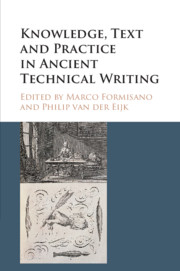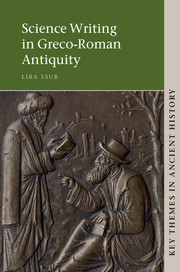Refine search
Actions for selected content:
13588 results in History of science and technology
Irrational “Coefficients” in Renaissance Algebra
-
- Journal:
- Science in Context / Volume 30 / Issue 2 / June 2017
- Published online by Cambridge University Press:
- 12 July 2017, pp. 141-172
- Print publication:
- June 2017
-
- Article
-
- You have access
- HTML
- Export citation
SIC volume 30 issue 2 Cover and Back matter
-
- Journal:
- Science in Context / Volume 30 / Issue 2 / June 2017
- Published online by Cambridge University Press:
- 12 July 2017, pp. b1-b3
- Print publication:
- June 2017
-
- Article
-
- You have access
- Export citation
Paul Bettsand Stephen A. Smith(eds.), Science, Religion and Communism in Cold War Europe. New York: Palgrave Macmillan, 2016. Pp. 307. ISBN 978-1-137-54638-8. £60.00 (hardback).
-
- Journal:
- The British Journal for the History of Science / Volume 50 / Issue 2 / June 2017
- Published online by Cambridge University Press:
- 13 June 2017, pp. 373-375
- Print publication:
- June 2017
-
- Article
- Export citation
Fay B. Alberti , This Mortal Coil: The Human Body in History and Culture. Oxford: Oxford University Press, 2016. Pp. xii + 289. ISBN 978-0-19-959903-5. £20.00 (hardback).
-
- Journal:
- The British Journal for the History of Science / Volume 50 / Issue 2 / June 2017
- Published online by Cambridge University Press:
- 13 June 2017, pp. 343-344
- Print publication:
- June 2017
-
- Article
- Export citation
BJH volume 50 issue 2 Cover and Back matter
-
- Journal:
- The British Journal for the History of Science / Volume 50 / Issue 2 / June 2017
- Published online by Cambridge University Press:
- 13 June 2017, pp. b1-b3
- Print publication:
- June 2017
-
- Article
-
- You have access
- Export citation
Marie Hicks , Programmed Inequality: How Britain Discarded Women Technologists and Lost Its Edge in Computing. Cambridge, MA: MIT Press, 2017. Pp. 342. ISBN 978-0-262-03554-5. £32.95.
-
- Journal:
- The British Journal for the History of Science / Volume 50 / Issue 2 / June 2017
- Published online by Cambridge University Press:
- 13 June 2017, pp. 368-369
- Print publication:
- June 2017
-
- Article
- Export citation
B. Estella Leopold , Stories from the Leopold Shack: Sand County Revisited. New York: Oxford University Press, 2016. Pp. xvi + 325. ISBN 978-0-19-046322-9. $27.95 (hardback).
-
- Journal:
- The British Journal for the History of Science / Volume 50 / Issue 2 / June 2017
- Published online by Cambridge University Press:
- 13 June 2017, pp. 363-365
- Print publication:
- June 2017
-
- Article
- Export citation
Aaron Panofsky , Misbehaving Science: Controversy and the Development of Behavior Genetics. Chicago: The University of Chicago Press, 2014. Pp. xi + 321. ISBN 978-0226-05845-0. £19.50 (paperback).
-
- Journal:
- The British Journal for the History of Science / Volume 50 / Issue 2 / June 2017
- Published online by Cambridge University Press:
- 13 June 2017, pp. 376-377
- Print publication:
- June 2017
-
- Article
- Export citation
Staffan Müller-Willeand Christina Brandt , Heredity Explored: Between Public Domain and Experimental Science, 1850–1930. Cambridge, MA: MIT Press, 2016. Pp. 472. ISBN: 978-0-262-03443-2. £36.00 (cloth).
-
- Journal:
- The British Journal for the History of Science / Volume 50 / Issue 2 / June 2017
- Published online by Cambridge University Press:
- 13 June 2017, pp. 360-362
- Print publication:
- June 2017
-
- Article
- Export citation
Léna Soler , Emiliano Trizioand Andrew Pickering(eds.), Science as It Could Have Been: Discussing the Contingency/Inevitability Problem. Pittsburgh: The University of Pittsburgh Press, 2015. Pp. 462. ISBN 978-0-8229-4445-4. $61.95 (hardback).
-
- Journal:
- The British Journal for the History of Science / Volume 50 / Issue 2 / June 2017
- Published online by Cambridge University Press:
- 13 June 2017, pp. 379-381
- Print publication:
- June 2017
-
- Article
- Export citation
The First Jewish Astronomers: Lunar Theory and Reconstruction of a Dead Sea Scroll
-
- Journal:
- Science in Context / Volume 30 / Issue 2 / June 2017
- Published online by Cambridge University Press:
- 12 July 2017, pp. 113-139
- Print publication:
- June 2017
-
- Article
- Export citation

The Rise of Early Modern Science
- Islam, China, and the West
-
- Published online:
- 25 May 2017
- Print publication:
- 06 June 2017
How Lives Became Lists and Scientific Papers Became Data: Cataloguing Authorship during the Nineteenth Century – Corrigendum
-
- Journal:
- The British Journal for the History of Science / Volume 50 / Issue 3 / September 2017
- Published online by Cambridge University Press:
- 23 May 2017, p. 567
- Print publication:
- September 2017
-
- Article
-
- You have access
- HTML
- Export citation
Lorenz Oken (1779–1851): Naturphilosophie and the reform of natural history
-
- Journal:
- The British Journal for the History of Science / Volume 50 / Issue 2 / June 2017
- Published online by Cambridge University Press:
- 18 May 2017, pp. 329-340
- Print publication:
- June 2017
-
- Article
- Export citation
Physics moves to the provinces: the Siberian physics community and Soviet power, 1917–1940
-
- Journal:
- The British Journal for the History of Science / Volume 50 / Issue 2 / June 2017
- Published online by Cambridge University Press:
- 15 May 2017, pp. 297-327
- Print publication:
- June 2017
-
- Article
- Export citation

Knowledge, Text and Practice in Ancient Technical Writing
-
- Published online:
- 27 April 2017
- Print publication:
- 19 April 2017
Past editors' favourite papers published during their time in office
-
- Journal:
- The British Journal for the History of Science / Volume 50 / Issue 2 / June 2017
- Published online by Cambridge University Press:
- 25 April 2017, pp. 173-179
- Print publication:
- June 2017
-
- Article
-
- You have access
- HTML
- Export citation
Galileo's legacy: a critical edition and translation of the manuscript of Vincenzo Viviani's Grati Animi Monumenta
-
- Journal:
- The British Journal for the History of Science / Volume 50 / Issue 2 / June 2017
- Published online by Cambridge University Press:
- 24 April 2017, pp. 181-228
- Print publication:
- June 2017
-
- Article
- Export citation
‘A very diadem of light’: exhibitions in Victorian London, the Parliamentary light and the shaping of the Trinity House lighthouses
-
- Journal:
- The British Journal for the History of Science / Volume 50 / Issue 2 / June 2017
- Published online by Cambridge University Press:
- 24 April 2017, pp. 249-265
- Print publication:
- June 2017
-
- Article
- Export citation

Science Writing in Greco-Roman Antiquity
-
- Published online:
- 20 April 2017
- Print publication:
- 03 April 2017


